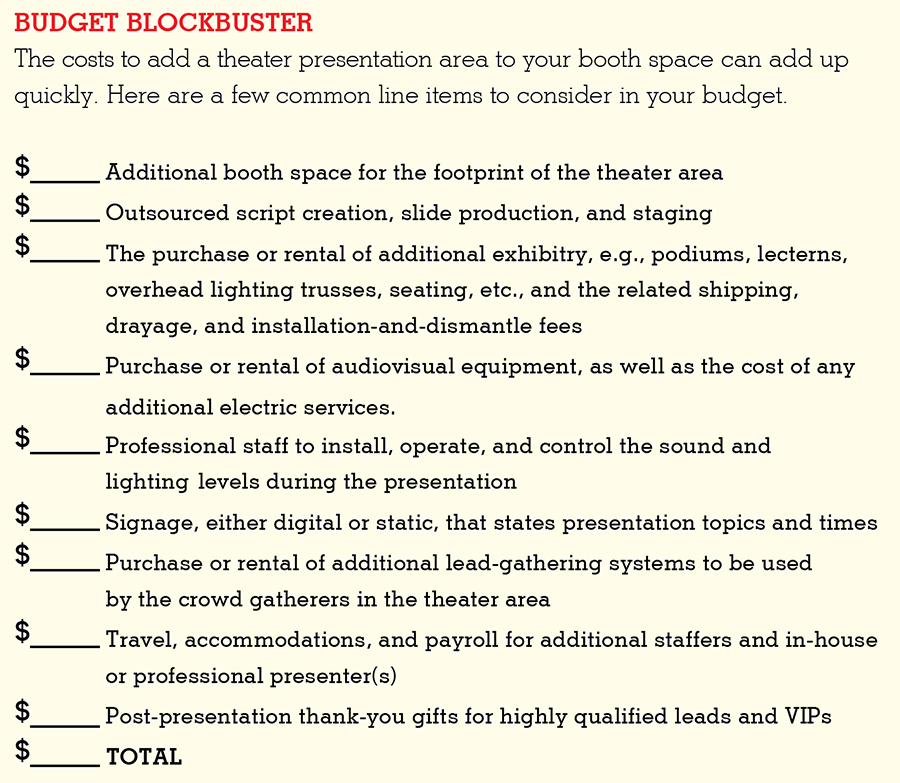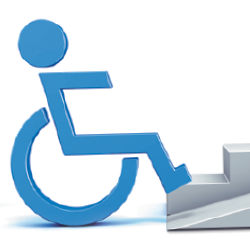|
exhibiting 101
 Trade Show Show Biz
Follow these tips to turn your in-booth presentations into attention-grabbing productions that awe attendees and boost the bottom line.
In-booth presentations are popular at trade shows for a number of reasons, chief among them being they give exhibitors an opportunity to convey key messages and product information in a consistent, persuasive, and (hopefully) engaging way. But how does one avoid yawn-inducing lectures and instead wow attendees with a dynamic live experience that attracts standing-room-only crowds? Read on for my firsthand tricks for staging a lead-generating piece of corporate theater.
Have Something to Say Before you start planning your in-booth presentation, ask yourself whether or not you have anything interesting to say. A boring presentation about a product or service you launched three years ago might do more harm than good, positioning your brand as dated and irrelevant. But if you have new products, new features on existing products, or a new marketing campaign, then a live presentation might be a good idea. Also consider an in-booth presentation if your primary objective at the show is to dispel myths about your company or products, demonstrate a complex technology, or educate attendees about who you are, what you do, and why they should buy your products. A well-crafted presentation can help you achieve these goals; plus, the one-to-many format of a presentation can help you reach a greater number of booth visitors and passersby than if you relied solely on one-on-one conversations. Once you've identified that you do, in fact, have something interesting to say to attendees, ask yourself if that message is relevant to a broad swath of attendees at the show. For example, if the bulk of the show's attendees represent your target audience and you're looking to announce a new product, then a presentation makes perfect sense. But if you're only targeting a tiny portion of the attendee population, then a formal presentation might be overkill. Develop Your Key Message Next, craft your message. Ask yourself, "What information made our current customers buy from us?" Attendees walking the show floor are looking for products and services that will help them cut costs, increase efficiency, and avoid hassles, and the most effective presentations demonstrate how a company or its offerings will do just that. So focus your presentation on the benefits of your product that will help attendees achieve those things, and your message is far more likely to resonate with the audience. Obviously, you don't have to limit yourself to one presentation. Some of the most successful in-booth presentation models alternate between general company/product overviews and varied product- or application-specific presentations. I've seen exhibitors post schedules of rotating topics, including everything from brief product-launch presentations and lengthier panel- or session-style discussions addressing customers' pain points to even providing case studies of how clients used the exhibitor's products or services to overcome a particular challenge. But remember, when it comes to in-booth presentations, it's generally best to keep things concise. Just as graphics with too much information are ineffective, endless presentations that drone on and on won't retain attendees' interest for long. My rule of thumb: A presentation should last no more than seven minutes, and attendees should be informed how long it will run when they are seated. Write the Script It's difficult to make an in-booth presentation sound like a naturally flowing monologue that integrates the data on a background slide while also engaging the audience. Don't feel bad if you decide that script writing isn't in your wheelhouse. Some freelance writers and full-service talent agencies can help you write the script, develop on-screen graphics or slide decks, and possibly even pick and prepare the presenter. But if a professionally produced script and visually stunning presentation aren't in your budget, you may have to resort to what I jokingly refer to as death-by-PowerPoint. In this case, my best advice is to remember that your slides are there to visually enhance and support your oral presentation, not to replace it verbatim. Limit each slide's content to one primary concept with a few bullet points and a graphic or chart, and use a typeface and font size that can be easily read from a distance. Practice Makes Perfect Before you get too far into your planning, decide who will be presenting. That person might be one of your staffers, a product specialist, a current customer, a business partner, or a professional presenter. If you pick someone who is not accustomed to presenting, such as a member of your company's research-and-development team, it is important he or she understands the scope of the assignment and is willing to rehearse – and I don't mean a couple of pre-show run-throughs during booth setup. Your presenter needs to memorize the script long before leaving for the show's host city. Then, hold a pre-show rehearsal in the exhibit using all audiovisual and presentation tools. This on-site test run is a chance for your presenter to polish his or her performance, get used to the microphone, deal with any AV problems, and work out any jitters. But if this is the first time your presenter has seen the script, you are begging for disaster. If you don't have any in-house staff willing to take on this job, you can find talent that specializes in trade show presentations through a trade show marketing or talent agency. Most large cities have several agencies, and there's usually an official one listed in the show manual. Set a Proper Stage Your presentation area should be highly visible from the aisle and inviting enough to draw in droves of attendees. Use a high-quality display and sound system so everything looks and sounds professional and so that attendees can see and hear clearly from a distance. Remember that the industry standard for the maximum decibel level when measured from the center of the aisle in front of your presentation space is 85 to 90 decibels. Exceeding this sound level will annoy other exhibitors, and it won't endear you to show management, since it will be fielding complaints from your neighbors. For brief presentations, you don't have to provide plush seating – just something to let your audience take a load off for a few minutes. You can rent stacking chairs, benches, hassocks, or horizontal "bum bars" to lean against. Whatever you choose, decide how to handle those attendees who stand behind your seating area and spill into the aisle. Your booth-space contract likely has a "confines of booth" clause that prohibits you from using the aisle space outside your exhibit. Obviously exhibitors can't totally control aisle traffic, but if your presentations continue to create crowds that block access to other exhibitors, show management might mandate that you hire security personnel to keep the crowd moving. 
When and how frequently should you hold your presentations? One consideration is your location on the show floor. It generally takes longer for attendees to get to the back and rear corners of the exhibit hall, so if your exhibit isn't front and center, you may want to delay your first presentation of the day until at least half an hour after the show doors open. And to avoid competing with surrounding exhibits, contact show management to get the names of your neighbors so you can coordinate the times of your presentations. It generally works out well if neighboring exhibitors agree on which one will present on the hour and half hour, with any others presenting on the quarter and three-quarters hour. You can even announce to the audience that "Our neighbor is getting ready to start a presentation on Topic X in just a few minutes" to cooperatively drive traffic between your exhibits. Build the Buzz Before the show, mail or email invitations to prospective attendees. Advertise your presentation schedule on your company's website, and if you plan on distributing gifts to thank attendees for coming to your presentation, promote those as well. Inform booth visitors when your next presentation will begin by using a programmable display or clock that boldly shows presentation start times. You can also post announcements on Twitter so those following you at the show can plan to attend the presentations that appeal to them. Measure Your Results All of your planning can be for naught if you don't have a surefire method to collect, manage, measure, and evaluate information from presentation participants. To capture demographic information, use either an electronic badge reader or manual lead forms on clipboards with pens. Make sure that you have sufficient booth staffers available to monitor the audience's buying signals during the presentation (having participants raise their hand in response to questions during the presentation is a great way to help staffers identify interested attendees) and to speak with prospects after each presentation is over. Having your presenter point attendees to staffers standing on the perimeter of the presentation area or toward demo stations within your booth can also help direct interested prospects to further conversations with your team. Set quantitative goals for both the number of presentation attendees and the number of qualified leads among that group. You can gather this data through your lead forms, audience-response systems, and/or notes from conversations between staff members and prospects indicating that they have attended your presentation. Also consider using crowd gatherers to administer exit surveys between presentations to record attendee feedback, such as whether the presentation triggered a change in perception of your brand or increased their interest in your company's products or services. Finally, don't forget to thank the booth visitors who took time out of their busy trade show schedules to attend your presentation. Whether it's just a sincere "Thank you" or a gift that's appropriate to your target audience, letting attendees know they're appreciated is the perfect finale to any in-booth presentation. E  Candy Adams
Candy AdamsCTSM, CEM, CMP, CMM "The Booth Mom," is an independent exhibit project manager, trainer, speaker, consultant, and an Exhibitor Conference faculty member. CandyAdams@BoothMom.com
|
|
|
||||||||||||||||||||||||||||
|
|
||||||||||||||||||||||||||||
|
TOPICS Measurement & Budgeting Planning & Execution Marketing & Promotion Events & Venues Personal & Career Exhibits & Experiences International Exhibiting Resources for Rookies Research & Resources |
MAGAZINE Subscribe Today! Renew Subscription Update Address Digital Downloads Newsletters Advertise |
FIND IT Exhibit Producers Products & Services All Companies Get Listed |
EXHIBITORLIVE Sessions Exhibit Hall Exhibit at the Show Registration |
ETRAK Sessions Certification F.A.Q. Registration |
EDUCATION WEEK Overview Sessions Hotel Registration |
CERTIFICATION The Program Steps to Certification Faculty and Staff Enroll in CTSM Submit Quiz Answers My CTSM |
AWARDS Exhibit Design Awards Portable/Modular Awards Corporate Event Awards Centers of Excellence |
NEWS Associations/Press Awards Company News International New Products People Shows & Events Venues & Destinations EXHIBITOR News |
||||||||||||||||||||
|
||||||||||||||||||||||||||||






